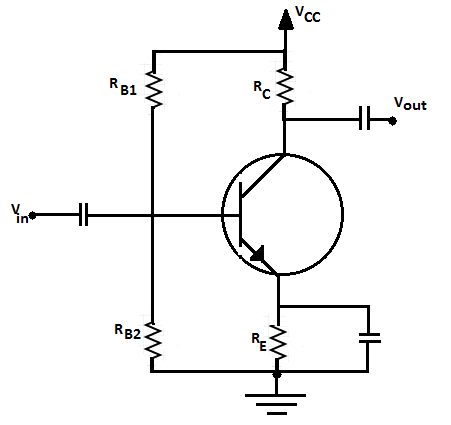
A transistor is used in common emitter mode as an amplifier. Then
(A) The base-emitter junction is forward biased
(B) The base emitter junction is reverse biased
(C) The input signal is connected in series with the voltage applied to the base-emitter junction.
(D) The input signal is connected in series with the voltage applied to the base collector junction.
Answer
558k+ views
Hint: When a transistor is configured as common emitter, common base and common collector, the input is connected to the terminal which is taken as common. Emitter is always forward based with respect to base, to supply majority charge carriers to the base. Collector terminal is always reverse biased with respect to the base to remove the charge carriers from the base collector junction.
Complete step by step answer:
Common emitter amplifier circuit

An amplifier is a device which is used for increasing the amplitude of input signals. And it produces an enlarged version of the input signal. In an amplifier there are two input terminals for connecting input and two output terminals for connecting load. In a common emitter amplifier configuration, base is one of the input terminals and collector is one of the output terminals. Emitter is common for both input and output. Hence, the input signal is connected in series with the voltage applied to the base-emitter junction.
For a proper functioning of a transistor, the emitter-base junction must be forward-biased and collector-base junction must be reverse-biased. Usually Emitter is forward biased with respect to base so as to supply the majority of the charge carriers to the base.
So, the correct answer is “Option A and C”.
Note:
Common emitter circuits are the most popular configuration in amplifier circuits. Because it's current, voltage and power gains are quite high and the ratio of output impedance and input impedance are quite moderate. As it provides high voltage gain and moderate current gain, CE circuits are well suited for voltage amplification, especially for low frequencies. Also, it is used as low noise amplifiers and radio frequency amplifiers.
Complete step by step answer:
Common emitter amplifier circuit

An amplifier is a device which is used for increasing the amplitude of input signals. And it produces an enlarged version of the input signal. In an amplifier there are two input terminals for connecting input and two output terminals for connecting load. In a common emitter amplifier configuration, base is one of the input terminals and collector is one of the output terminals. Emitter is common for both input and output. Hence, the input signal is connected in series with the voltage applied to the base-emitter junction.
For a proper functioning of a transistor, the emitter-base junction must be forward-biased and collector-base junction must be reverse-biased. Usually Emitter is forward biased with respect to base so as to supply the majority of the charge carriers to the base.
So, the correct answer is “Option A and C”.
Note:
Common emitter circuits are the most popular configuration in amplifier circuits. Because it's current, voltage and power gains are quite high and the ratio of output impedance and input impedance are quite moderate. As it provides high voltage gain and moderate current gain, CE circuits are well suited for voltage amplification, especially for low frequencies. Also, it is used as low noise amplifiers and radio frequency amplifiers.
Recently Updated Pages
Master Class 12 English: Engaging Questions & Answers for Success

Master Class 12 Business Studies: Engaging Questions & Answers for Success

Master Class 12 Economics: Engaging Questions & Answers for Success

Master Class 12 Social Science: Engaging Questions & Answers for Success

Master Class 12 Maths: Engaging Questions & Answers for Success

Master Class 12 Chemistry: Engaging Questions & Answers for Success

Trending doubts
What are the major means of transport Explain each class 12 social science CBSE

Differentiate between homogeneous and heterogeneous class 12 chemistry CBSE

Draw a ray diagram of compound microscope when the class 12 physics CBSE

How is democracy better than other forms of government class 12 social science CBSE

What is virtual and erect image ?

Explain the energy losses in the transformer How are class 12 physics CBSE




